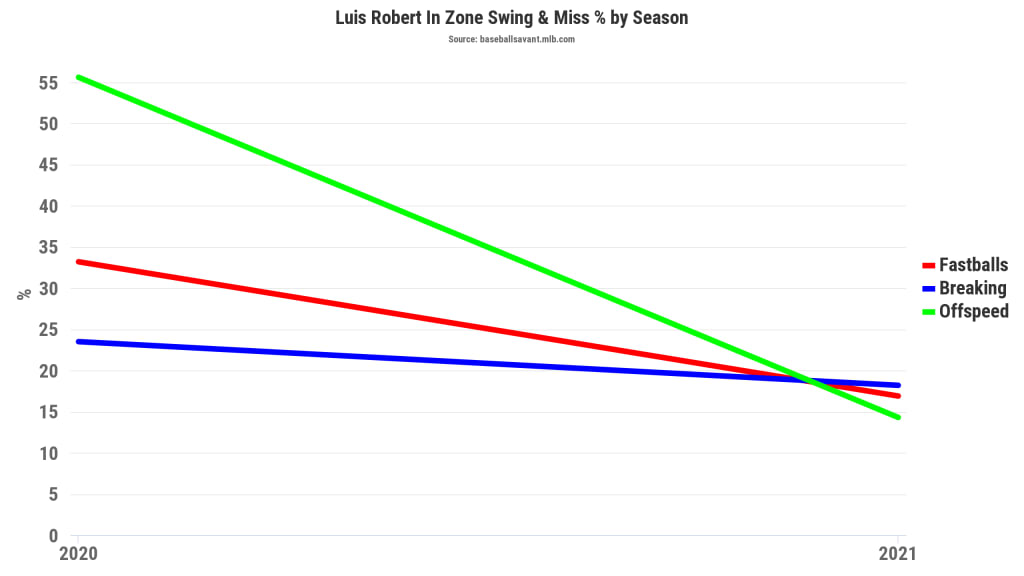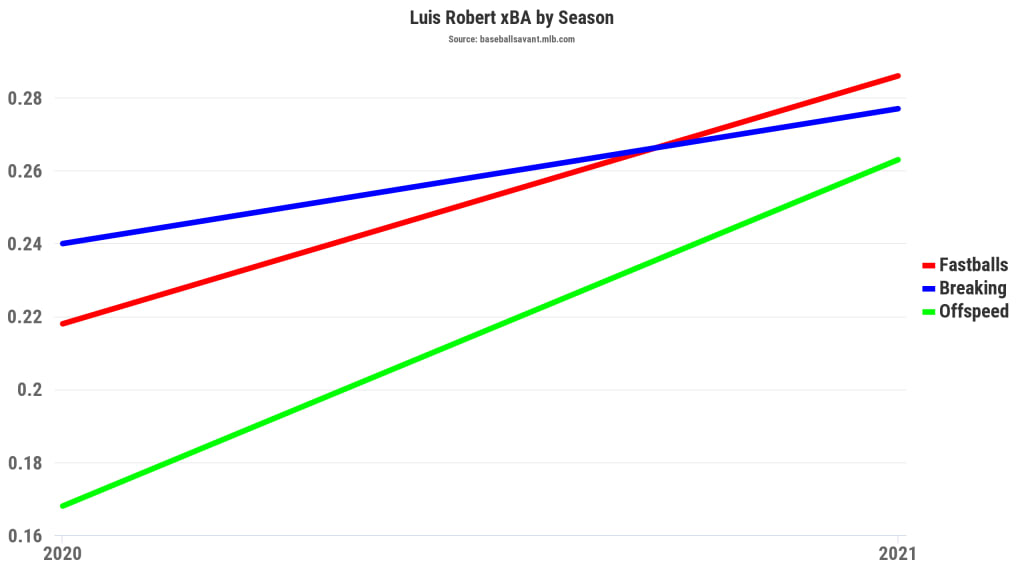Luis Robert loves to swing. That seems only natural. When you can crush a baseball like he does, how could you not want to get up there and hack?
But when you hack, you have to connect, and when Robert was slumping through the latter part of his rookie season, he was having a lot of issues connecting. This season, he's taken a step toward resolving those issues, which could help unlock his potential as a hitter.
If you're going to attack well over half the pitches you see, like Robert does, you need to hit the ones that are in the strike zone. That's your opportunity to do damage, and Robert knows it -- he swings at four of every five pitches he sees in the zone, one of the highest rates in the game. But in 2020, Robert's contact rate on those pitches in the strike zone was only 68.3% -- third-worst of the 121 hitters who swung at at least 250 in-zone pitches.
This season, he's raised his in-zone contact rate to a much better 82.2% -- giving him the biggest percentage-point increase in in-zone contact rate from 2020-21.
Largest increase in in-zone contact rate, 2020-21
Among 193 qualifying hitters
1) Luis Robert (CWS): +14.5 points (68.3% to 82.8%)
2) Omar Narvaez (MIL): +13.2 points (77.2% to 90.4%)
3) Nicky Lopez (KC): +12.4 points (82.4% to 94.8%)
4) Gregory Polanco (PIT): +12.3 points (66.8% to 79.1%)
5) Ronald Acuña Jr. (ATL): +10.7 points (73.7% to 84.4%)
That's encouraging, and one of the reasons he's hitting .305 right now after his .233 average in 2020.
Robert's power hasn't quite shown up yet this season -- he has only one home run through 21 games -- but if he keeps connecting with those hittable in-zone pitches, the homers will have to come. He hits the ball too hard for them not too. Robert's maximum exit velocity of 113.6 mph this season ranks in the 94th percentile of MLB, and we know he can hit it even harder -- his 115.8 mph max exit velo from last year was in the 98th percentile of MLB.
Robert is improving against all three pitch types: fastballs, breaking balls and offspeed pitches. He's cut down his swing-and-miss numbers against all of those within the strike zone.
Robert's in-zone swing-and-miss rate by pitch type, 2020-21
Fastballs: 33.2% to 16.9% (-16.3 points)
Breaking: 23.5% to 18.2% (-5.3 points)
Offspeed: 55.6% to 14.3% (-41.3 points)

The fact that he's improved so much at making contact against both fastballs and offspeed pitches would suggest Robert's timing at the plate is better this season.
Last year, for example, Robert struggled to square up even plain old fastballs. He whiffed on 44% of his swings vs. four-seamers, one of the highest rates in the league. A slugger of Robert's talent shouldn't be whiffing on that many fastballs. This year, thanks to his improvement within the strike zone, his overall whiff rate vs. four-seamers is down to 27%. Still high, but better.
More contact against pitches in the strike zone should help Robert's overall stat line. He has basically the same hard-hit rate in 2021 that he did in '20 (41% in '20, 42% in '21) and the same barrel rate (13% in '20, 12% in '21). That's on a per-batted-ball basis, and more in-zone contact should mean more balls in play, and ideally more hard-hit and barreled balls.
By connecting with more in-zone pitches, Robert gets better contact quality. His expected batting average against fastballs, breaking balls and offspeed pitches is up across the board.
Robert's xBA vs. each pitch type, 2020-21
Fastballs: .218 to .286 (+68 points)
Breaking: .240 to .277 (+37 points)
Offspeed: .168 to .263 (+95 points)
Overall: .223 to .279 (+56 points)

Hopefully the slugging stats are next to jump if Robert continues to cut down on his swing-and-miss and strikeouts -- his K% is down from 32.2% to 25.6% so far -- and drives those hittable in-zone pitches with authority. We all want to see the six-tool player put up the numbers to match.
